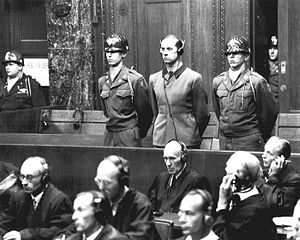
The U.S. War Crimes Tribunal sentence Adolf Hitler's personal physician, 43-year-old Karl Brandt to death at the Doctors' Trial in August 1947. Brandt, who had been Reich Commisser for Health and Sanitation, was indicted with 22 other Nazi doctors and SS officers. The Tribunal found him guilty on all four counts charging him with conspiracy in aggressive wars, war crimes, crimes against humanity, and membership in the criminal SS organization. Among those criminal acts was his participating in and consenting to using concentration camp inmates as test subjects in medical experiments.
The SS Medical Corps was a formation within the SS of professional doctors who provided medical services for the SS, including experiments on and the development of different methods of murdering prisoners.
Formation[]
The first units of the SS Medical Corps began to appear in the 1930s. Within each SS-Sturmbann (battalion), there existed one company of SS personnel whose duty was to serve as medical support personnel to the rest of the SS battalion.
Known as the Sanitätsstaffel, these formations were originally small units under the command of local SS leaders. After 1931, however, the SS formed a headquarters office known as Amt V, which was the central office for SS medical units. At this same time, a special SS unit was formed known as the Röntgensturmbann SS-HA, or the Hauptamt X-Ray Battalion. This formation comprised 350 full time SS personnel who toured Germany offering X-ray diagnostics to any SS member. While the Röntgensturmbann was an independent office, the local Sanitätsstaffel were under dual command of both the SS Medical Office (Amt V), and the leaders of the various SS-Sturmbann and Standarten.
When the Nazis came to power in 1933, the SS was reorganized and an office of the SS Surgeon General was established. Commanded by an SS-Obergruppenführer, the SS Surgeon General was a member of the personal staff of the Reichsführer-SS, with the SS Medical Corps, as a whole, losing the status of a headquarters office. This was an important development in changing the nature of service for members of the SS Medical Corps.
By 1935, the SS Medical Corps was considered an 'auxiliary duty', and all members of the medical corps were also attached to regular SS formations. To denote medical corps status, the SS authorized a serpent crest to be worn on the collar patches of SS unit insignia. Because SS Medical Corps members could now serve in any branch of the SS, this expansion allowed medical professionals to join every SS office and participate in a variety of duties.
Medical experiments[]

Nazi gas van used to murder people at Chelmno extermination camp.

Carpathian Ruthenian Jews arrive at Auschwitz–Birkenau, May 1944. The camp SS doctors would carry out the selection process generally after arrival.
Between 1935 and 1938, the SS Medical Corps began to serve a more sinister purpose, with SS doctors serving in concentration camps and engaging in a variety of human medical experiments. SS doctors were also called upon, in 1936, to assist with Germany's euthanasia program against the mentally disabled and physically handicapped. They helped develop the first methods of gassing patients using carbon monoxide from the exhaust fumes of lorries (vans), for example.
When World War II began in 1939, the SS Medical Corps extended itself in the Armed wing of the SS which would, by 1941, be known as the Waffen-SS. Waffen-SS doctors were highly trained both in medical skills and combat tactics with many such doctors receiving high combat awards.
It was also during World War II that SS doctors reached their height with human medical experiments, the most notorious of which occurred at Dachau concentration camp and Auschwitz. Such experiments ranged from vivisections, sterilization experiments, infectious disease research, freezing experiments, as well as many other excruciating medical procedures often performed without anesthetic. During this period of time one of the most infamous SS doctors, Doctor Josef Mengele, served as Head Medical Officer of Auschwitz and was responsible for the daily gas chamber selections as well as brutal experiments (including those on human twins).
Nuremburg trials[]
In 1945, after the surrender of Germany, the SS was declared an illegal criminal organization by the Nuremburg trial. SS doctors, in particular, were marked as war criminals due to the wide range of human medical experimentation which had been conducted during World War II as well as the role SS doctors had played in the gas chamber selections of the Holocaust. Relatively few SS doctors, however, were ever brought to justice with such figures as Josef Mengele escaping to Argentina while still other SS doctors returned to civilian practice in Germany under assumed names or, in some cases, even their original identities.
See also[]
Notes[]
The original article can be found at SS Medical Corps and the edit history here.